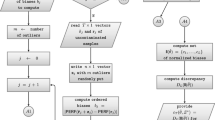Abstract
In this work the precision of point and interval estimators for some performance measures for risky financial assets is analyzed and the conditions under which the point estimators are asymptotically normally distributed are provided. The findings of this research suggest that a huge number of observations is needed to get reasonably precise point and interval estimates. Therefore, the considered performance measures may be surely employed as descriptive statistics for ex-post performance comparisons but they should be employed with caution in ex-ante evaluations for investment choices.


Similar content being viewed by others
References
Alexander, G.J., Baptista, A.M.: Portfolio evaluation using value at risk. J. Portf. Manag. 29(4), 93–102 (2003)
Andrews, D.W.K.: Heteroscedasticity and autocorrelation consistent covariance matrix estimation. Econometrica 59, 817–858 (1991)
Biglova, A., Ortobelli, S., Rachev, S., Stoyanov, S.: Different approaches to risk estimation in portfolio theory. J. Portf. Manag. 31, 103–112 (2004)
Carrasco, M., Chen, X.: Mixing and moment properties of various GARCH and stochastic volatility models. Econ. Theory 18, 17–39 (2002)
De Capitani, L., Zenga, M.: Point and interval estimation for some financial performance measures. Statistica & Applicazioni IX(2), 129–158 (2011)
De Capitani, L.: Interval estimation for the sharpe ratio when returns are not i.i.d. with special emphasis on the \(GARCH(1,1)\) process with symmetric innovations. Stat. Methods Appl. 21(4), 517–537 (2012)
De Capitani, L.: Interval estimation for the Sortino Ratio and the Omega Ratio. Commun. Stat. Simul. Comput. 43(6), 1385–1429 (2014)
Denker, M., Keller, G.: On \(U\)-statistics and v. Mises’ statistics for weakly dependent processes. Z. Wahrscheinlichkeitstheorie Verwandte Gebiete 64, 505–522 (1983)
Farinelli, S., Ferreira, M., Rossello, D., Thoeny, M., Tibiletti, L.: Beyond Sharpe ratio: Optimal asset allocation using different performance ratios. J. Bank. Financ 32, 2057–2063 (2008)
Favre, L., Galeano, J.A.: Mean-modified value-at-risk optimization with hedge fund. J. Altern. Invest. 5, 21–25 (2002)
Ibragimov, I.A., Linnik, Y.V.: Independent and Stationary Sequences of Random Variables. Wolters-Noordhoff, Netherlands (1971)
Keating, C., Shadwick, W.F.: A Universal Performance Measure. J. Perform. Meas. 6, 59–84 (2002)
Konno, H., Yamazaki, H.: Mean-absolute deviation portfolio optimization model and its application to Tokyo stock market. Manag. Sci. 37, 519–531 (1991)
Lindner, A.M.: Stationarity, mixing, distributional properties and moments of GARCH(p, q)-processes. In: Andersen, T.G., Davis, R.A., Kreib, J.-P., Mikosch, Th.V. (eds.) Handbook of Financial Time Series, Spriger (2009)
Lo, A.W.: The statistics of sharpe ratio. Financ. Anal. J. 58, 36–52 (2002)
Lumley, T., Heagerty, P.: Weighted empirical adaptive variance estimators for correlated data regression. J. R. Stat. Soc. B 61, 459–477 (1999)
Markowitz, H.: Portfolio selection. J. Financ. 7(1), 77–91 (1952)
Nelson, D.B.: Stationarity and persistence in the GARCH(1,1) model. Econ. Theory 6(3), 318–334 (1990)
Newey, W.K., West, K.D.: A simple positive semi-definite, heteroskedasticity and autocorrelation consistent covariance matrix. Econometrica 55, 703–708 (1987)
Newey, W.K., West, K.D.: Automatic lag selection in covariance matrix estimation. Rev. Econ. Stud. 61, 631–653 (1994)
Development Core Team R: A language and environment for statistical computing. R Foundation for Statistical Computing, Vienna, Austria (2004). ISBN 3-900051-00-3, http://www.R-project.org/
Shalit, H., Yitzhaki, S.: Mean-Gini, risky asset. J. Financ. 39, 1449–1468 (1984)
Sharpe, W.F.: Capital asset prices: a theory of market equilibrium under conditions of risk. J. Financ. 19, 425–442 (1964)
Sharpe, W.F.: Mutual fund performance. J. Bus. 39, 119–138 (1966)
Sortino, F., Van der Meer, R.: Downside risk. J. Portf. Manag. 17(4), 27–31 (1991)
Sortino, F., Price, L.: Performance measurement in a downside risk framework. J. Invest. 3(3), 59–64 (1994)
Yoshihara, K.: The Bahadur representation of sample quantiles for sequences of strongly mixing random variables. Stat. Probab. Lett. 24(4), 209–304 (1995)
Zeileis, A.: Econometric Computing with HC and HAC covariance matrix estimators. J. of Stat. Softw. 11(10), http://www.jstatsoft.org/ (2004)
Author information
Authors and Affiliations
Corresponding author
Appendix
Appendix
Lemma 1
Let \(F\) be a continuous df and let \((X_1,...,X_n)\) a sample with possibly dependent elements drawn from \(F\). Let \(\widehat{F}_n\) be the ecdf based on \((X_1,...,X_n)\) and assume that \(\widehat{F}_{n}(x)=F(x)+O_{p}(n^{-1/2})\) for all \(x\in \mathbb {R}\) as \(n\rightarrow \infty \). Let \(\widehat{z}_{n}\) be an estimator of \(z\) such that \(\widehat{z}_{n}=z+O_{p}(n^{-1/2})\) for \(n\rightarrow \infty \). Consider the functional \(I_{X}=\int _{-\infty }^{z}(z-x) dF(x)\) and its estimator \(\widehat{I}_{n}=\int _{-\infty }^{\widehat{z}_{n}}(\widehat{z}_{n}-x) d\widehat{F}_{n}(x)\). The following asymptotic representation for \(\widehat{I}_{n}\) holds:
Proof
and since
we may write
where
and
Thus, it remains to show that \(R_{1;n}\) and \(R_{2;n}\) are both of order \(o_{P}(n^{-1/2})\). \(R_{1;n}=o_{P}(n^{-1/2})\) follows immediately from the assumptions that \(\widehat{F}_{n}(x)=F(x)+O_{p}(n^{-1/2})\) for all \(x\in \mathbb {R}\) and \(\widehat{z}_{n}=z+O_{p}(n^{-1/2})\), while proving \(R_{2;n}=o_{P}(n^{-1/2})\) requires a further argument: we first estimate \(|R_{2;n}|\) by
and since, by assumption, \(\widehat{z}_{n}-z=O_{p}(n^{-1/2})\), it remains to show that
To this end we observe that
where \(\widehat{F}_{n}(z)-F(z)=O_{p}(n^{-1/2})\) by assumption, \(F(\widehat{z}_{n})-F(z)=o_{p}(1)\) by the continuity assumption on \(F\) and by the assumption that \(\widehat{z}_{n}=z+O_{P}(n^{-1/2})\), and finally
since pointwise convergence of \(\widehat{F}_{n}(x)\) to \(F(x)\) implies uniform convergence. \(\square \)
Rights and permissions
About this article
Cite this article
De Capitani, L., Pasquazzi, L. Inference for performance measures for financial assets. METRON 73, 73–98 (2015). https://doi.org/10.1007/s40300-014-0055-y
Received:
Accepted:
Published:
Issue Date:
DOI: https://doi.org/10.1007/s40300-014-0055-y




